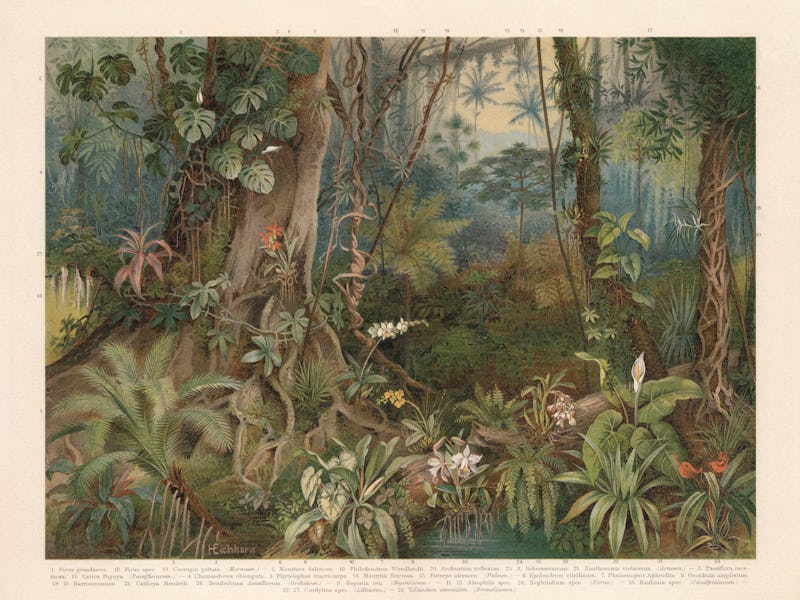Deforestation's unexpected side effect on climate change
Pay attention to the edges of the forest, experts warn.

Sometimes called the planet's "lungs," the rainforests of the Amazon play an important role in regulating Earth's carbon dioxide levels.
Forests thick with trees stash away CO2, lightening the load of the greenhouse gas. But the effect is dramatically reduced at the edges of the rainforest. There, clear-cutting projects of industries like lumber and palm oil weaken the forest's integrity.
New research quantifies exactly what we lose along the boundaries where forest meets agriculture.
From 2001 to 2015, the Amazon forest lost 947 million tons of carbon storage along its edges, a new study finds. That's one-third the quantity of carbon lost due to all deforestation in the same time period.
And while forest health improved overall during the timeframe studied — carbon lost because of deforestation dropped by 7 million tons per year — carbon losses at the edge of the forest did not change.
Instead, this side-effect of deforestation, called an "edge effect," has persisted heartily.
"Deforestation is the primary driver of carbon losses in tropical forests, but it does not operate alone," write the authors of the study, published Wednesday in the journal Science Advances.
"Forest fragmentation, a resulting feature of the deforestation process, promotes indirect carbon losses induced by edge effect."
That process is not implicitly considered when making we create policies to reduce carbon emissions in the tropics — but it should be, the researchers argue in the new study.
Illustration showing how deforestation changes forest edge ecosystems.
"Our results indicate that there is a significant missing source to be considered in the Amazonian carbon budget," the study authors write. "Including carbon losses related to edge effect in regional and global carbon budgets is, hence, crucial for accurately estimate the land-use and land-cover change contribution to the atmospheric carbon burden."
Laser focus — To understand just how significant the mechanisms at the forest's edge really are, the researchers analyzed 15 years of data collected using laser scans.
The team of scientists, led by researcher Celso H. L. Silva Junior, used Light Detection and Ranging, or LiDAR, to scan treetops and observe the extent of edge effects. They processed airborne LiDAR data to create a model for carbon loss based on the age of a forest edge. They also used remote sensing data from 2000 to 2015 to visualize this effect.
Above-ground carbon storage loss in the Amazon between 2001 and 2015.
Using lasers scans in this way is not new. Previous work has similarly taken advantage of the technology to estimate how patchy forests absorb carbon dioxide. One study, conducted in Malaysian Borneo, found that reduced carbon storage at the edge of the forest extends more than 300 feet into the forest.
LiDAR has also helped researchers identify (and climb) the Amazon's tallest tree: a member of the species Dinizia excelsa, which stands 288 feet tall in a grove of more than a dozen other 200-foot-plus giants.
Those mammoth trees survived last year's intense Amazon wildfires. But protecting them in the long-term is not a given, and neither is preserving the benefit that old-growth trees offer the planet.
With the new research, scientists and policymakers have a new data point to consider when working out how the world will respond to the existential challenge of climate change. The researchers say factoring in edge effects can reshape our outlook on the future of climate change when considering international efforts to reduce emissions, namely the Paris Agreement.
"Carbon losses caused by edge effect is thus an additional unquantified flux that can counteract carbon emissions avoided by reducing deforestation," they write, "compromising the Paris Agreement's bold targets."
Abstract: Deforestation is the primary driver of carbon losses in tropical forests, but it does not operate alone. Forest fragmentation, a resulting feature of the deforestation process, promotes indirect carbon losses induced by edge effect. This process is not implicitly considered by policies for reducing carbon emissions in the tropics. Here, we used a remote sensing approach to estimate carbon losses driven by edge effect in Amazonia over the 2001 to 2015 period. We found that carbon losses associated with edge effect (947 Tg C) corresponded to one-third of losses from deforestation (2592 Tg C). Despite a notable negative trend of 7 Tg C year−1 in carbon losses from deforestation, the carbon losses from edge effect remained unchanged, with an average of 63 ± 8 Tg C year−1. Carbon losses caused by edge effect is thus an additional unquantified flux that can counteract carbon emissions avoided by reducing deforestation, compromising the Paris Agreement's bold targets.